Effects of Ultrafine Fly Ash against Sulphate Reaction in Concrete Structures
Abstract
:1. Introduction
Importance and Purpose of the Research
2. Materials and Methods
2.1. Cement
2.2. Fly Ash
2.3. Aggregate
2.4. Mixing Water
2.5. Method
2.6. Specific Surface Area
2.7. Preparation of Concrete Mixtures
2.8. Test of Ultrasonic Pulse Velocity
2.9. Test of Weight Loss
2.10. Test of Compressive Strength
3. Results
3.1. The Values of Weight Loss of Sulphated Concrete
3.2. The Values of Ultrasonic Pulse Velocity of Sulphated Concrete
4. Conclusions
- It has been observed that the weight loss in fly ash-doped concrete has lower values than the reference concrete. The fineness of fly ash and the grinding effect reduced the weight loss values. In addition, the weight loss values increased due to the sulphate solution ratio to which the concrete was exposed and the increase in cycle time.
- Grinding fly ash to a finer size better filled the voids and improved the concrete’s impermeability. Thus, the gaps in the concrete were filled, and higher results were obtained in compressive strength and ultrasonic pulse velocity values.
- Compressive strength losses occurred as the admixture rate increased in fly ash-added concrete samples with different fineness values. The highest to lowest compressive strength values were observed in concretes with 30%, 10%, and 50% fly ash replacement, respectively.
- According to the fly ash substitution rate, the highest weight loss in concrete samples exposed to a 5% Na2SO4 solution was observed in concrete samples with 50% substitution and the lowest in concrete samples with 30% substitution. The reason is that using waste material such as fly ash in concrete at a high value, such as 50%, has caused an increase in pressure loss and weight loss.
- Compared to the samples kept in a 5% Na2SO4 solution, lower ultrasonic pulse velocity data were obtained. However, the decreases in the ultrasonic pulse velocity experiments obtained after the increase in the solution could be more apparent.
- Blaine fineness values of 1555, 1632, 2347, 2589, 2766, and 3433 cm2/g were obtained after grinding fly ash for 0, 10, 20, 30, 45, and 60 minutes, respectively. The percent increase in Blaine fineness values after grinding fly ash at different times was calculated, and the effect of fineness was evaluated. The increase in grinding time on the fineness value was calculated as 4.95%, 50.93%, 66.49%, 77.88%, and 120.77%, respectively. This value positively affected the study’s weight loss, compressive strength, and ultrasonic pulse velocity values. However, in the experimental studies obtained before and after the maximum grinding of fly ash, the desired results were obtained in the values of the experimental results when the substitution rate was used in low and medium amounts. For example, a fly ash substitution of 50% in the mixture caused a decrease in the values of the experimental results. If the grinding time was kept longer and the fly ash was thinned, the weight losses could be lower, and the pressure and ultrasonic pulse velocity values could be higher in concrete with a 50% fly ash substitution. Thus, fly ash, a natural waste product, could be utilized at a higher rate in concrete.
- It was observed that the increase in fly ash fineness increased the pressure and ultrasonic pulse velocity values and decreased the weight loss values in all data. These values decreased depending on the increase in the amount of Na2SO4 solution to which the concrete was exposed. Optimum test results were seen in concrete samples with 30% replacement fly ash. The ideal replacement rate, pressure, ultrasonic pulse velocity value, and minimum weight loss were found at 30%, 10%, and 50% replacement rates, respectively. It has been observed that very high and very low fly ash waste rates in concrete do not increase the properties of concrete.
- This study analysed the Blaine values of fly ash as a substitute for cement and showed that it has a preventive effect, particularly on sulphate reactions that damage concrete. According to these results, an increase in concrete performance is achieved, allowing the construction of more economical and sustainable structures.
Author Contributions
Funding
Institutional Review Board Statement
Informed Consent Statement
Data Availability Statement
Acknowledgments
Conflicts of Interest
References
- Kılınçarslan, Ş.; Başyiğit, C.; İsmail, U. Mechanical Properties of Sulphate Attack on Heavy Weight Concrete. SDU Int. Technol. Sci. 2010, 2, 60–71. [Google Scholar]
- Baradan, B.; Yazıcı, H. Stability in Concrete Structures and What’s New with the TS EN 206-1 Standard. Turkey’s Eng. News 2003, 3, 426. [Google Scholar]
- Nayak, D.K.; Abhilash, P.P.; Singh, R.; Kumar, R.; Kumar, V. Fly Ash for Sustainable Construction: A Review of Fly Ash Concrete and Its Beneficial Use Case Studies. Clean. Mater. 2022, 6, 100143. [Google Scholar] [CrossRef]
- Liu, P.; Chen, Y.; Wang, W.; Yu, Z. Effect of Physical and Chemical Sulfate Attack on Performance Degradation of Concrete under Different Conditions. Chem. Phys. Lett. 2020, 745, 137254. [Google Scholar] [CrossRef]
- Ren, J.; Lai, Y.; Bai, R.; Qin, Y. The Damage Mechanism and Failure Prediction of Concrete under Wetting–Drying Cycles with Sodium Sulfate Solution. Constr. Build. Mater. 2020, 264, 120525. [Google Scholar] [CrossRef]
- Zhang, Z.; Zhou, J.; Yang, J.; Zou, Y.; Wang, Z. Understanding of the Deterioration Characteristic of Concrete Exposed to External Sulfate Attack: Insight into Mesoscopic Pore Structures. Constr. Build. Mater. 2020, 260, 119932. [Google Scholar] [CrossRef]
- ASTM C1012-04; Standard Test Method for Length Change of Hydraulic-Cement Mortars Exposed to a Sulfate Solution. ASTM International: West Conshohocken, PA, USA, 2010; p. 3.
- Ma, H.; Gong, W.; Yu, H.; Sun, W. Durability of Concrete Subjected to Dry-Wet Cycles in Various Types of Salt Lake Brines. Constr. Build. Mater. 2018, 193, 286–294. [Google Scholar] [CrossRef]
- Mayhoub, O.A.; Nasr, E.S.A.R.; Ali, Y.A.; Kohail, M. The Influence of Ingredients on the Properties of Reactive Powder Concrete: A Review. Ain Shams Eng. J. 2021, 12, 145–158. [Google Scholar] [CrossRef]
- Busch, P.; Kendall, A.; Murphy, C.W.; Miller, S.A. Literature Review on Policies to Mitigate GHG Emissions for Cement and Concrete. Resour. Conserv. Recycl. 2022, 182, 106278. [Google Scholar] [CrossRef]
- Baradan, B.; Aydın, S. The Durability of Concrete (Durability, Retention). In Proceedings of the Concrete 2013 Plant Concrete Congress, Turkey, November–December 2013; pp. 265–288. [Google Scholar]
- Wang, X.; Wu, D.; Zhang, J.; Yu, R.; Hou, D.; Shui, Z. Design of Sustainable Ultra-High Performance Concrete: A Review. Constr. Build. Mater. 2021, 307, 124643. [Google Scholar] [CrossRef]
- Chindaprasirt, P.; Homwuttiwong, S.; Sirivivatnanon, V. Influence of Fly Ash Fineness on Strength, Drying Shrinkage and Sulfate Resistance of Blended Cement Mortar. Cem. Concr. Res. 2004, 34, 1087–1092. [Google Scholar] [CrossRef]
- Al-Akhras, N.M. Durability of Metakaolin Concrete to Sulfate Attack. Cem. Concr. Res. 2006, 36, 1727–1734. [Google Scholar] [CrossRef]
- Al-Amoudi, O.S.B. Sulfate Attack and Reinforcement Corrosion in Plain and Blended Cements Exposed to Sulfate Environments. Build. Environ. 1998, 33, 53–61. [Google Scholar] [CrossRef]
- Neville, A. The Confused World of Sulfate Attack on Concrete. Cem. Concr. Res. 2004, 34, 1275–1296. [Google Scholar] [CrossRef]
- Kılınç, K.; Uyan, M. The Effect of Sulphate Salts in Concrete Mix Water on Cement Mortar Properties. In Proceedings of the 5 National Concrete Congress, Durability of Concrete (Durability), Istanbul, Turkey, 1–3 October 2003. [Google Scholar]
- Nehdi, M.; Hayek, M. Behavior of Blended Cement Mortars Exposed to Sulfate Solutions Cycling in Relative Humidity. Cem. Concr. Res. 2005, 35, 731–742. [Google Scholar] [CrossRef]
- Lee, S.T.; Moon, H.Y.; Hooton, R.D.; Kim, J.P. Effect of Solution Concentrations and Replacement Levels of Metakaolin on the Resistance of Mortars Exposed to Magnesium Sulfate Solutions. Cem. Concr. Res. 2005, 35, 1314–1323. [Google Scholar] [CrossRef]
- Boudache, S.; Loukili, A.; Izoret, L.; Rozière, E. Investigating the Role Played by Portlandite and C-A-S-H in the Degradation Response of Pozzolanic and Slag Cements to External Sulphate Attack. J. Build. Eng. 2023, 67, 106053. [Google Scholar] [CrossRef]
- Hilloulin, B.; Hafidi, A.; Boudache, S.; Loukili, A. Interpretable Ensemble Machine Learning for the Prediction of the Expansion of Cementitious Materials under External Sulfate Attack. J. Build. Eng. 2023, 80, 107951. [Google Scholar] [CrossRef]
- Chen, Y.; Liu, P.; Yu, Z. Study on Degradation of Macro Performances and Micro Structure of Concrete Attacked by Sulfate under Artificial Simulated Environment. Constr. Build. Mater. 2020, 260, 119951. [Google Scholar] [CrossRef]
- Faried, A.S.; Mostafa, S.A.; Tayeh, B.A.; Tawfik, T.A. Mechanical and Durability Properties of Ultra-High Performance Concrete Incorporated with Various Nano Waste Materials under Different Curing Conditions. J. Build. Eng. 2021, 43, 102569. [Google Scholar] [CrossRef]
- Huang, B.; Dong, Q.; Burdette, E.G. Laboratory Evaluation of Incorporating Waste Ceramic Materials into Portland Cement and Asphaltic Concrete. Constr. Build. Mater. 2009, 23, 3451–3456. [Google Scholar] [CrossRef]
- Gu, G.P.; Beaudoin, J.J.; Ramachandran, V.S. Techniques for Corrosion Investigation in Reinforced Concrete. In Handbook of Analytical Techniques in Concrete Science and Technology; Elsevier: Amsterdam, The Netherlands, 2001; pp. 441–504. [Google Scholar]
- Erdoğdu, Ş.; Kurbetçi, Ş. To the Performance of the Concrete in Terms of the Activity They Provide Chemical and Mineral Additive Materials. Turkey’s Eng. News 2003, 426, 115–120. [Google Scholar]
- Baradan, B.; Yazici, H.; Ün, H. Durability of Concrete and Reinforced Concrete Structures; Turkey Ready Mixed Concrete Association: Istanbul, Turkey, 2010. [Google Scholar]
- Irassar, E.F.; Di Maio, A.; Batic, O.R. Sulfate Attack on Concrete with Mineral Admixtures. Cem. Concr. Res. 1996, 26, 113–123. [Google Scholar] [CrossRef]
- Medina, C.; Sánchez de Rojas, M.I.; Frías, M. Reuse of Sanitary Ceramic Wastes as Coarse Aggregate in Eco-Efficient Concretes. Cem. Concr. Compos. 2012, 34, 48–54. [Google Scholar] [CrossRef]
- Higashiyama, H.; Yagishita, F.; Sano, M.; Takahashi, O. Compressive Strength and Resistance to Chloride Penetration of Mortars Using Ceramic Waste as Fine Aggregate. Constr. Build. Mater. 2012, 26, 96–101. [Google Scholar] [CrossRef]
- Pereira-de-Oliveira, L.A.; Castro-Gomes, J.P.; Santos, P.M.S. The Potential Pozzolanic Activity of Glass and Red-Clay Ceramic Waste as Cement Mortars Components. Constr. Build. Mater. 2012, 31, 197–203. [Google Scholar] [CrossRef]
- Senthamarai, R.M.; Manoharan, P.D.; Gobinath, D. Concrete Made from Ceramic Industry Waste: Durability Properties. Constr. Build. Mater. 2011, 25, 2413–2419. [Google Scholar] [CrossRef]
- Franus, W.; Dudek, K.; Franus, W.; Dudek, K. Clay Minerals and Clinoptilolite from the Variegated Shales Formation in the Skole Unit, Polish Flysch Carpathians. Geol. Carpathica 1999, 50, 23–24. [Google Scholar]
- Feng, N.-Q.; Peng, G.-F. Applications of Natural Zeolite to Construction and Building Materials in China. Constr. Build. Mater. 2005, 19, 579–584. [Google Scholar] [CrossRef]
- Najimi, M.; Sobhani, J.; Ahmadi, B.; Shekarchi, M. An Experimental Study on Durability Properties of Concrete Containing Zeolite as a Highly Reactive Natural Pozzolan. Constr. Build. Mater. 2012, 35, 1023–1033. [Google Scholar] [CrossRef]
- Yazıcı, H. Investigation on Sulfate Resistance of Blast Furnace Slag Mortars. J. Dokuz Eylül Univ. Sci. Eng. 2006, 8, 51–58. [Google Scholar]
- Mehta, P.K.; Monteiro, P.J. Concrete: Microstructure, Properties, and Materials; McGraw-Hill Education: New York, NY, USA, 2014. [Google Scholar]
- Lv, X.; Yang, L.; Li, J.; Wang, F. Roles of Fly Ash, Granulated Blast-Furnace Slag, and Silica Fume in Long-Term Resistance to External Sulfate Attacks at Atmospheric Temperature. Cem. Concr. Compos. 2022, 133, 104696. [Google Scholar] [CrossRef]
- Yuan, Y.; Zhang, W.; Sun, G.; Wang, Y.; Wu, F.; Zhang, Y. Study on the Effect of Mineral Admixture on the Water Stability of UHPC under Long-Term Immersion. Constr. Build. Mater. 2023, 380, 131276. [Google Scholar] [CrossRef]
- Bonen, D. A Microstructural Study of the Effect Produced by Magnesium Sulfate on Plain and Silica Fume-Bearing Portland Cement Mortars. Cem. Concr. Res. 1993, 23, 541–553. [Google Scholar] [CrossRef]
- Biricik, H.; Aköz, F.; Türker, F.; Berktay, I. Resistance to Magnesium Sulfate and Sodium Sulfate Attack of Mortars Containing Wheat Straw Ash. Cem. Concr. Res. 2000, 30, 1189–1197. [Google Scholar] [CrossRef]
- Dodson, V.H. Concrete Admixtures; Springer Science & Business Media: Bergisch Gladbach, Germany, 2013. [Google Scholar]
- Shah, H.A.; Yuan, Q.; Photwichai, N. Use of Materials to Lower the Cost of Ultra-High-Performance Concrete—A Review. Constr. Build. Mater. 2022, 327, 127045. [Google Scholar] [CrossRef]
- Al-Dulaijan, S.U.; Maslehuddin, M.; Al-Zahrani, M.M.; Sharif, A.M.; Shameem, M.; Ibrahim, M. Sulfate Resistance of Plain and Blended Cements Exposed to Varying Concentrations of Sodium Sulfate. Cem. Concr. Compos. 2003, 25, 429–437. [Google Scholar] [CrossRef]
- Santhanam, M.; Cohen, M.D.; Olek, J. Mechanism of Sulfate Attack: A Fresh Look. Cem. Concr. Res. 2003, 33, 341–346. [Google Scholar] [CrossRef]
- Shi, C.; Stegemann, J.A. Acid Corrosion Resistance of Different Cementing Materials. Cem. Concr. Res. 2000, 30, 803–808. [Google Scholar] [CrossRef]
- Bahmani, H.; Mostofinejad, D. Microstructure of Ultra-High-Performance Concrete (UHPC)—A Review Study. J. Build. Eng. 2022, 50, 104118. [Google Scholar] [CrossRef]
- Li, J.; Wu, Z.; Shi, C.; Yuan, Q.; Zhang, Z. Durability of Ultra-High Performance Concrete—A Review. Constr. Build. Mater. 2020, 255, 119296. [Google Scholar] [CrossRef]
- De Belie, N.; Verselder, H.J.; De Blaere, B.; Van Nieuwenburg, D.; Verschoore, R. Influence of the Cement Type on the Resistance of Concrete to Feed Acids. Cem. Concr. Res. 1996, 26, 1717–1725. [Google Scholar] [CrossRef]
- Rattanachu, P.; Tangchirapat, W.; Jaturapitakkul, C. Water Permeability and Sulfate Resistance of Eco-Friendly High-Strength Concrete Composed of Ground Bagasse Ash and Recycled Concrete Aggregate. J. Mater. Civ. Eng. 2019, 31, 04019093. [Google Scholar] [CrossRef]
- Cordeiro, G.C.; Toledo Filho, R.D.; Tavares, L.M.; Fairbairn, E.M.R. Pozzolanic Activity and Filler Effect of Sugar Cane Bagasse Ash in Portland Cement and Lime Mortars. Cem. Concr. Compos. 2008, 30, 410–418. [Google Scholar] [CrossRef]
- Rerkpiboon, A.; Tangchirapat, W.; Jaturapitakkul, C. Strength, Chloride Resistance, and Expansion of Concretes Containing Ground Bagasse Ash. Constr. Build. Mater. 2015, 101, 983–989. [Google Scholar] [CrossRef]
- Nie, Q.; Zhou, C.; Li, H.; Shu, X.; Gong, H.; Huang, B. Numerical Simulation of Fly Ash Concrete under Sulfate Attack. Constr. Build. Mater. 2015, 84, 261–268. [Google Scholar] [CrossRef]
- Ouyang, C.; Nanni, A.; Chang, W.F. Internal and External Sources of Sulfate Ions in Portland Cement Mortar: Two Types of Chemical Attack. Cem. Concr. Res. 1988, 18, 699–709. [Google Scholar] [CrossRef]
- Anwar Hossain, K.M. Resistance of Scoria-Based Blended Cement Concrete against Deterioration and Corrosion in Mixed Sulfate Environment. J. Mater. Civ. Eng. 2009, 21, 299–308. [Google Scholar] [CrossRef]
- Gupta, N.; Siddique, R. Sulfate Resistance and Drying Shrinkage of Self-Compacting Concrete Incorporating Copper Slag. J. Mater. Civ. Eng. 2020, 32, 04020389. [Google Scholar] [CrossRef]
- Hossain, K.M.A.; Lachemi, M. Performance of Volcanic Ash and Pumice Based Blended Cement Concrete in Mixed Sulfate Environment. Cem. Concr. Res. 2006, 36, 1123–1133. [Google Scholar] [CrossRef]
- Türker, F.; Aköz, F.; Koral, S.; Yüzer, N. Effects of Magnesium Sulfate Concentration on the Sulfate Resistance of Mortars with and without Silica Fume. Cem. Concr. Res. 1997, 27, 205–214. [Google Scholar] [CrossRef]
- Marchand, J.; Odler, I.; Skalny, J.P. Sulfate Attack on Concrete.; CRC Press: Boca Raton, FL, USA, 2001. [Google Scholar]
- Ju, Y.; Zhang, H.; Wang, D.; Kong, X.; Ma, Y.; Zhang, X.; Bai, J. Effect of Mineral Admixtures on the Resistance to Sulfate Attack of Reactive Powder Concrete. J. Clean. Prod. 2024, 440, 140769. [Google Scholar] [CrossRef]
- ASTM C618-22; Standard Specification for Coal Fly Ash and Raw or Calcined Natural Pozzolan for Use in Concrete. ASTM: West Conshohocken, PA, USA, 2022; pp. 1–5.
- TS 802; Design of Concrete Mixes. TSE: Ankara, Turkey, 2016.
- TS EN 196-6; Methods of Testing Cement Part 6: Determination of Fineness. TSE: Ankara, Turkey, 2020.
- ASTM C597-16; Standard Test Method for Pulse Velocity Through Concrete. ASTM: West Conshohocken, PA, USA, 2016; p. 4.
- TS EN 12390-3 (2010); Testing Hardened Concrete-Part 3: Compressive Strength of Test Specimens. TSE: Ankara, Turkey, 2010.
- Fournier, B.; Bilodeau, A.; Bouzoubaa, N.; Nkinamubanzi, P.C. Field and Laboratory Investigations on the Use of Fly Ash and Li-Based Admixtures to Prevent ASR in Concrete. In Proceedings of the Sixth International Conference on the Durability of Concrete, Structures, Leeds, UK, 18–20 July 2018; University of Leeds: Leeds, West Yorkshire, UK, 2019; pp. 1–10. [Google Scholar]
- Shaikh, F.U.A.; Supit, S.W.M.; Sarker, P.K. A Study on the Effect of Nano Silica on Compressive Strength of High Volume Fly Ash Mortars and Concretes. Mater. Des. 2014, 60, 433–442. [Google Scholar] [CrossRef]
- Siddique, R. Performance Characteristics of High-Volume Class F Fly Ash Concrete. Cem. Concr. Res. 2004, 34, 487–493. [Google Scholar] [CrossRef]
- Naik, T.R.; Singh, S.S.; Hossain, M.M. Permeability of Concrete Containing Large Amounts of Fly Ash. Cem. Concr. Res. 1994, 24, 913–922. [Google Scholar] [CrossRef]
- Supit, S.W.M.; Shaikh, F.U.A. Durability Properties of High Volume Fly Ash Concrete Containing Nano-Silica. Mater. Struct. 2015, 48, 2431–2445. [Google Scholar] [CrossRef]
- Tkaczewska, E.; Małolepszy, J. Hydration of Coal–Biomass Fly Ash Cement. Constr. Build. Mater. 2009, 23, 2694–2700. [Google Scholar] [CrossRef]
- Sinsiri, T.; Teeramit, P.; Jaturapitakkul, C.; Kiattikomol, K. Effect of Finenesses of Fly Ash on Expansion of Mortars in Magnesium Sulfate. ScienceAsia 2006, 32, 063. [Google Scholar] [CrossRef]
- Arel, H.Ş.; Shaikh, F.U.A. Effects of Fly Ash Fineness, Nano Silica, and Curing Types on Mechanical and Durability Properties of Fly Ash Mortars. Struct. Concr. 2018, 19, 597–607. [Google Scholar] [CrossRef]
- Binici, H.; Eken, M.; Dinçer, A. Some Properties of Durability of Silica Fume, Fly Ash and Blast Furnace Slag Added Concretes. Çukurova Univ. J. Fac. Eng. Archit. 2013, 28, 11–20. [Google Scholar]
- Balakrishnan, B.; Abdul Awal, A.S.M. Durability Properties of Concrete Containing High Volume Malaysian Fly Ash. Int. J. Res. Eng. Technol. 2014, 03, 529–533. [Google Scholar] [CrossRef]
- Alnkaa, A. Effect of Curing Conditions on Properties of Geopolymer; Kastamonu University Institute of Sciences: Kastamonu, Turkey, 2019. [Google Scholar]
- Kanthe, V.N. Effect of Superplasticizer on Strength and Durability of Rice Husk Ash Concrete. Iran. J. Energy Environ. 2021, 12, 204–208. [Google Scholar] [CrossRef]
- Rozario, A.A.; Christy, D.C.F.; Angelin, M.H. Experimental Studies on Effects of Sulphate Resistance on Self-Curing Concrete. Int. J. Eng. Res. Technol. (IJERT) 2013, 2, 1–8. [Google Scholar]
- Corral Higuera, R.; Arredondo Rea, S.P.; Flores, N.; Gómez Soberón, J.M.V.; Almeraya Calderón, F.; Castorena González, J.H.; Almaral Sánchez, J.L. Sulfate Attack and Reinforcement Corrosion in Concrete with Recycled Concrete Aggregates and Supplementary Cementing Materials. Int. J. Electrochem. Sci. 2011, 6, 613–621. [Google Scholar] [CrossRef]
- Liu, K.W.; Deng, M.; Mo, L.W. Effect of Fly Ash on Resistance to Sulfate Attack of Cement-Based Materials. Key Eng. Mater. 2013, 539, 124–129. [Google Scholar] [CrossRef]
- Aydin, E.; Balkis, A.P. Preliminary Study on the Durability Properties of High-Volume Fly Ash Mortar Composites. J. Test. Eval. 2017, 45, 2029–2038. [Google Scholar] [CrossRef]
- Rao, M.K.; Satish Kumar, C.N. Influence of Fly Ash on Hydration Compounds of High-Volume Fly Ash Concrete. AIMS Mater. Sci. 2021, 8, 301–320. [Google Scholar] [CrossRef]
- Saha, A.K. Effect of Class F Fly Ash on the Durability Properties of Concrete. Sustain. Environ. Res. 2018, 28, 25–31. [Google Scholar] [CrossRef]
- Wang, A.; Zhang, C.; Sun, W. Fly Ash Effects: I. The Morphological Effect of Fly Ash. Cem. Concr. Res. 2003, 33, 2023–2029. [Google Scholar] [CrossRef]
- Wang, A.; Zhang, C.; Sun, W. Fly Ash Effects: III. The Microaggregate Effect of Fly Ash. Cem. Concr. Res. 2004, 34, 2061–2066. [Google Scholar] [CrossRef]
- De Weerdt, K.; Haha, M.B.; Le Saout, G.; Kjellsen, K.O.; Justnes, H.; Lothenbach, B. Hydration Mechanisms of Ternary Portland Cements Containing Limestone Powder and Fly Ash. Cem. Concr. Res. 2011, 41, 279–291. [Google Scholar] [CrossRef]

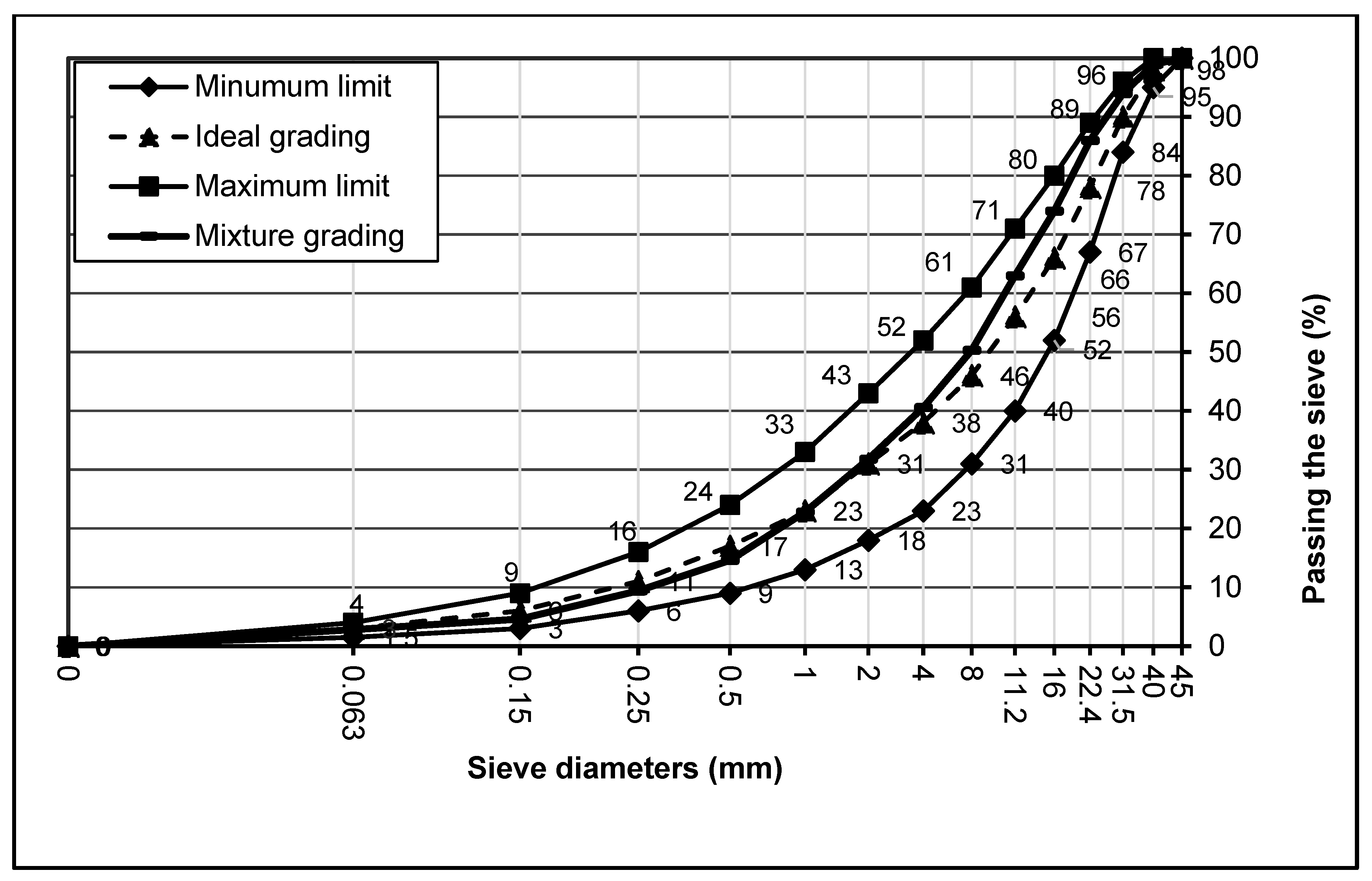
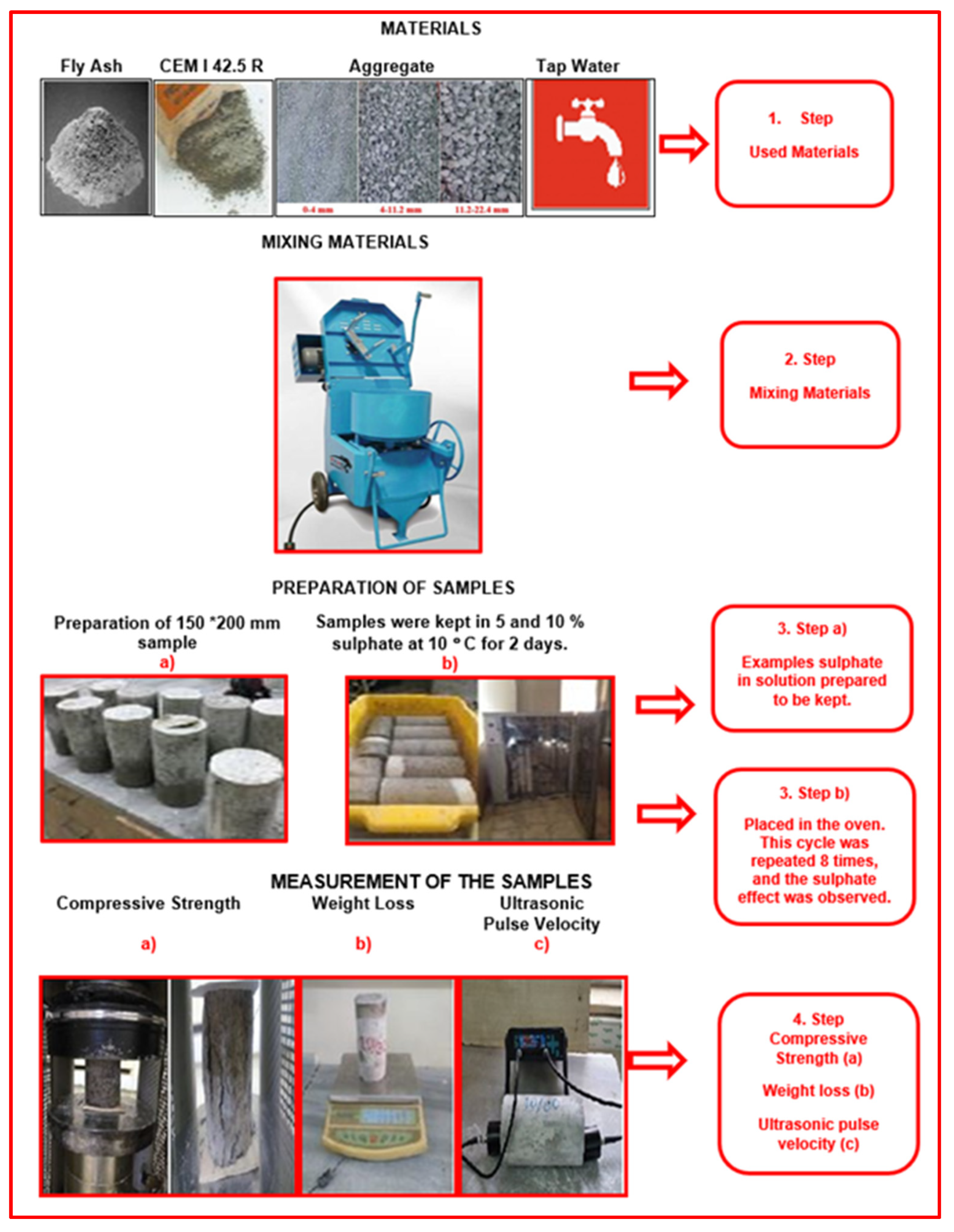
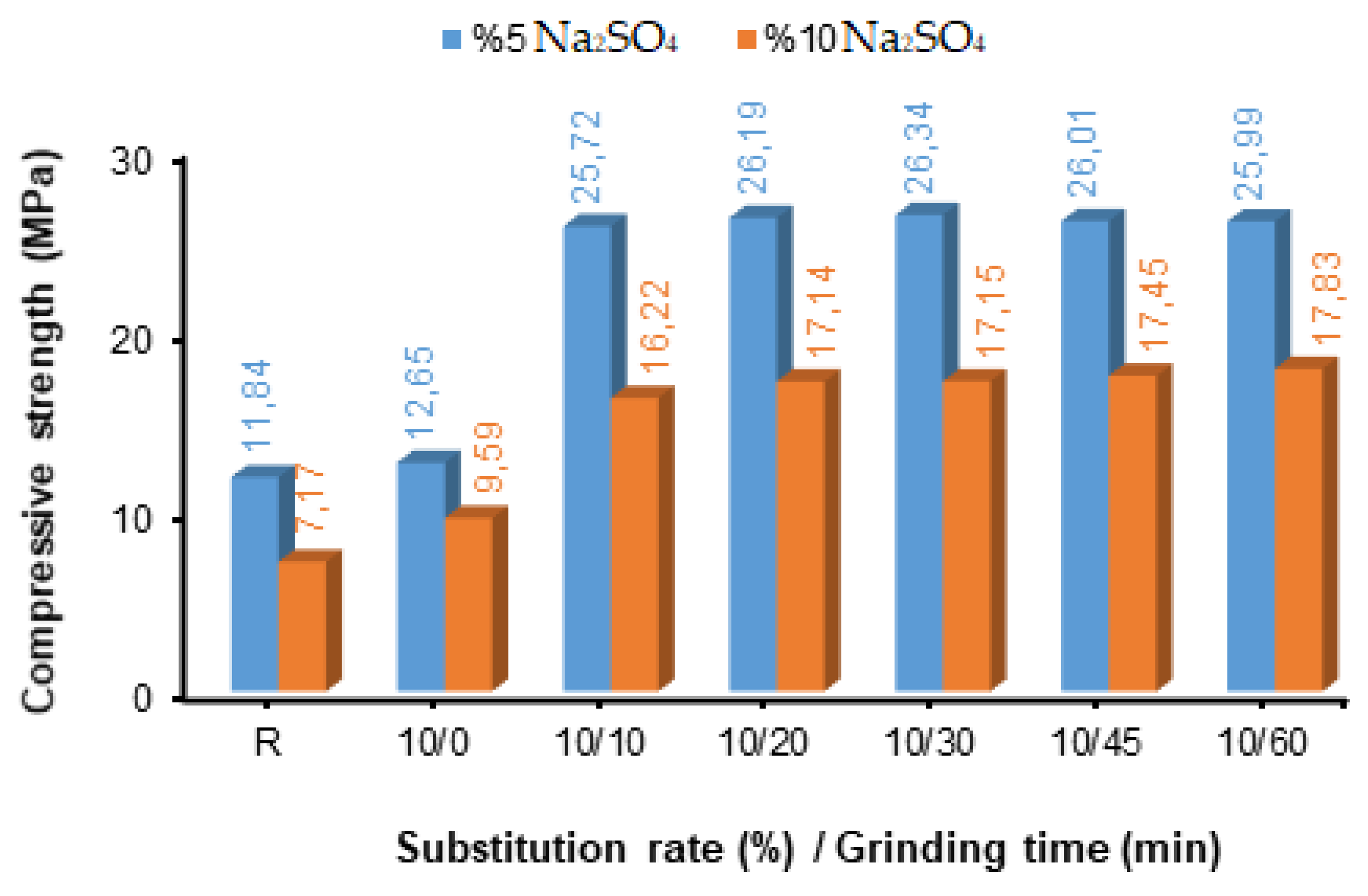
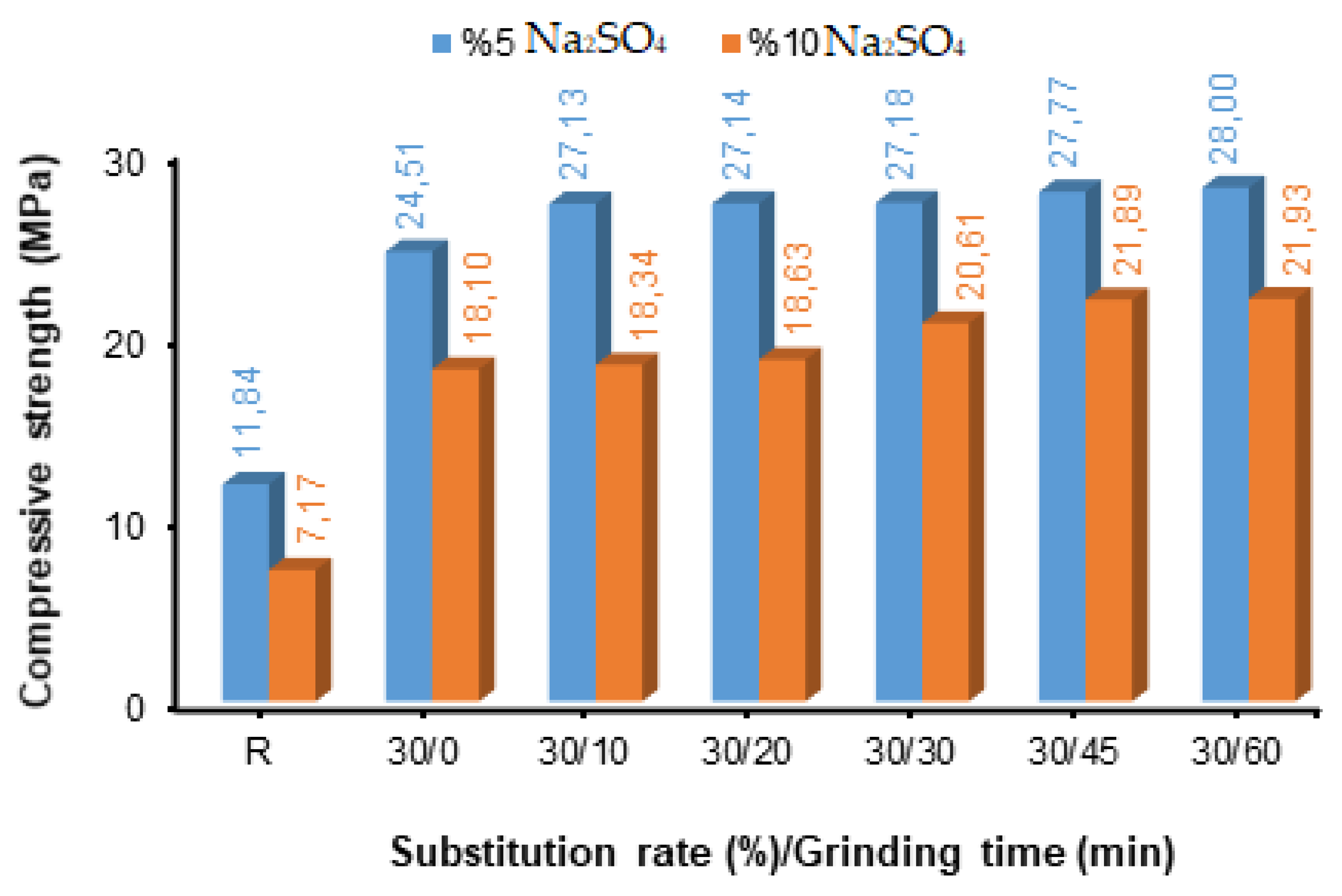
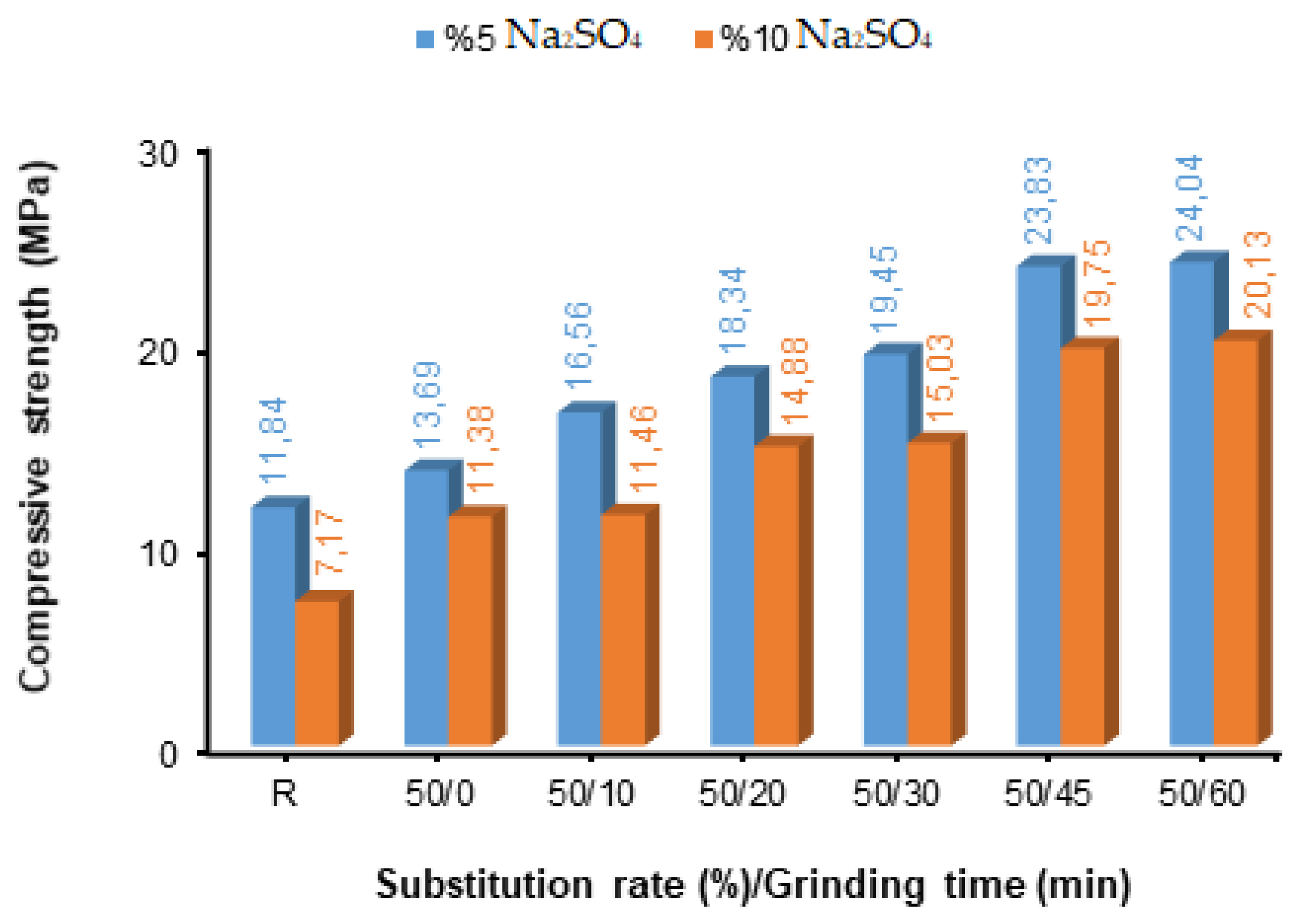


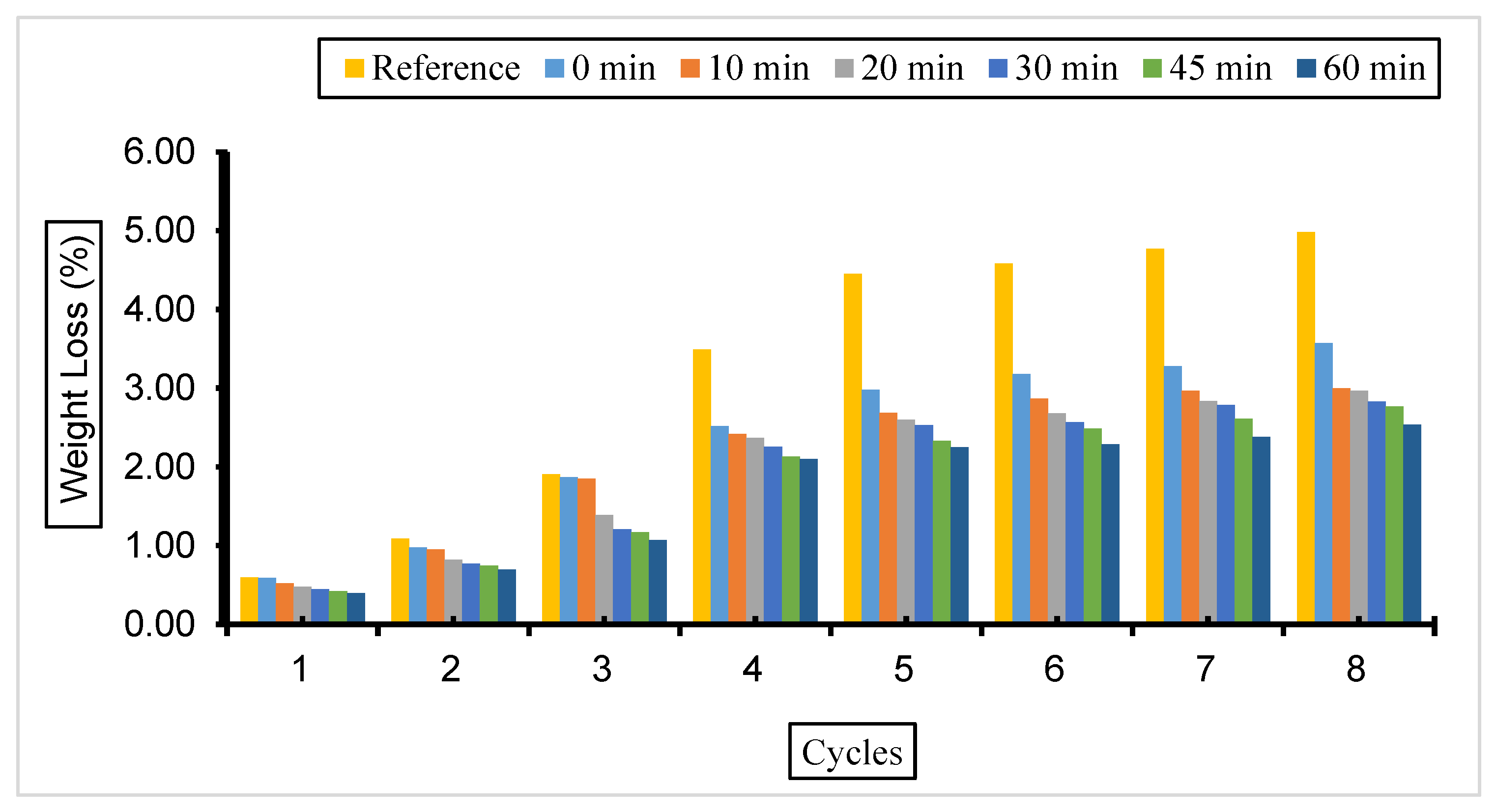
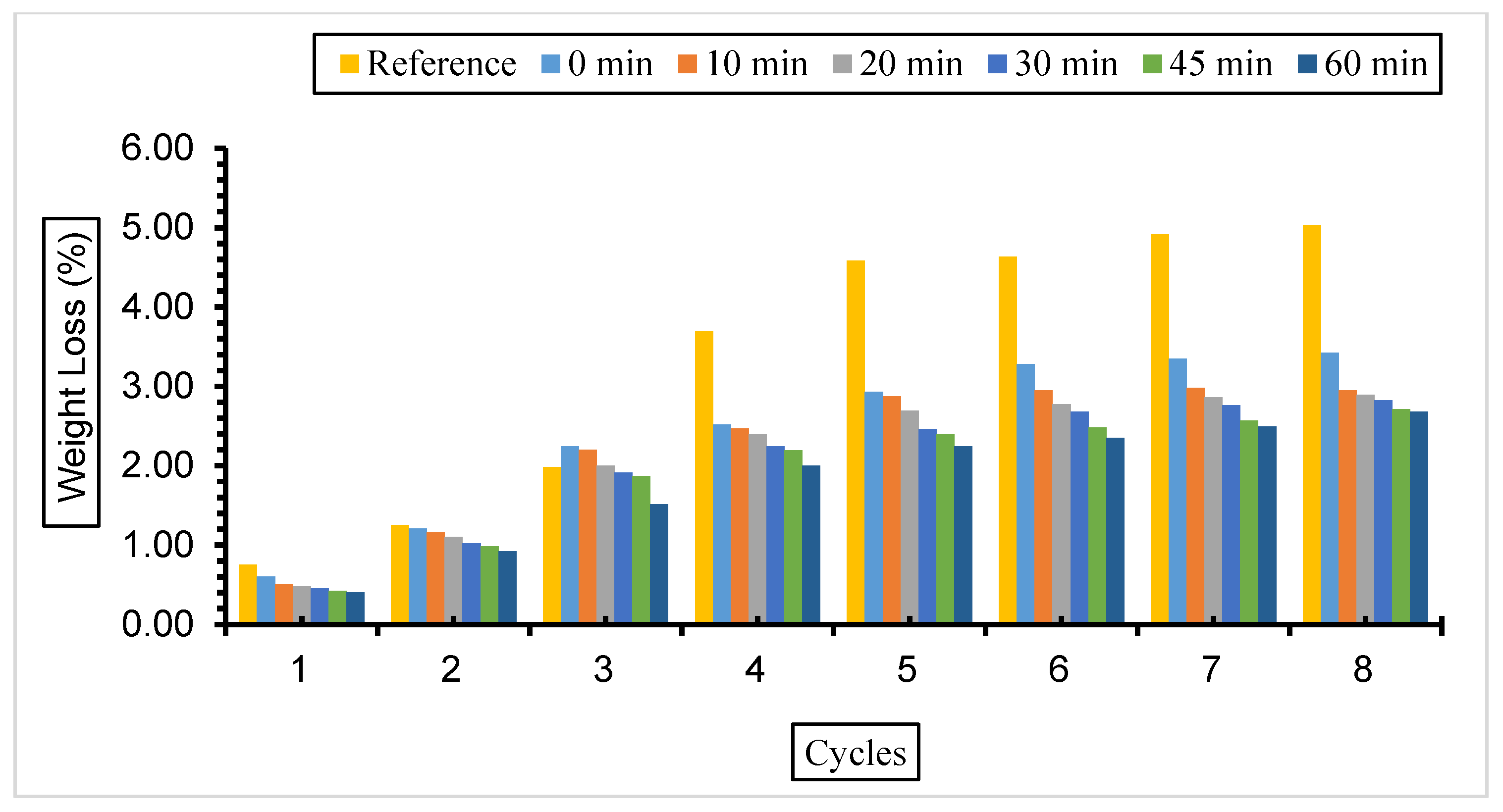
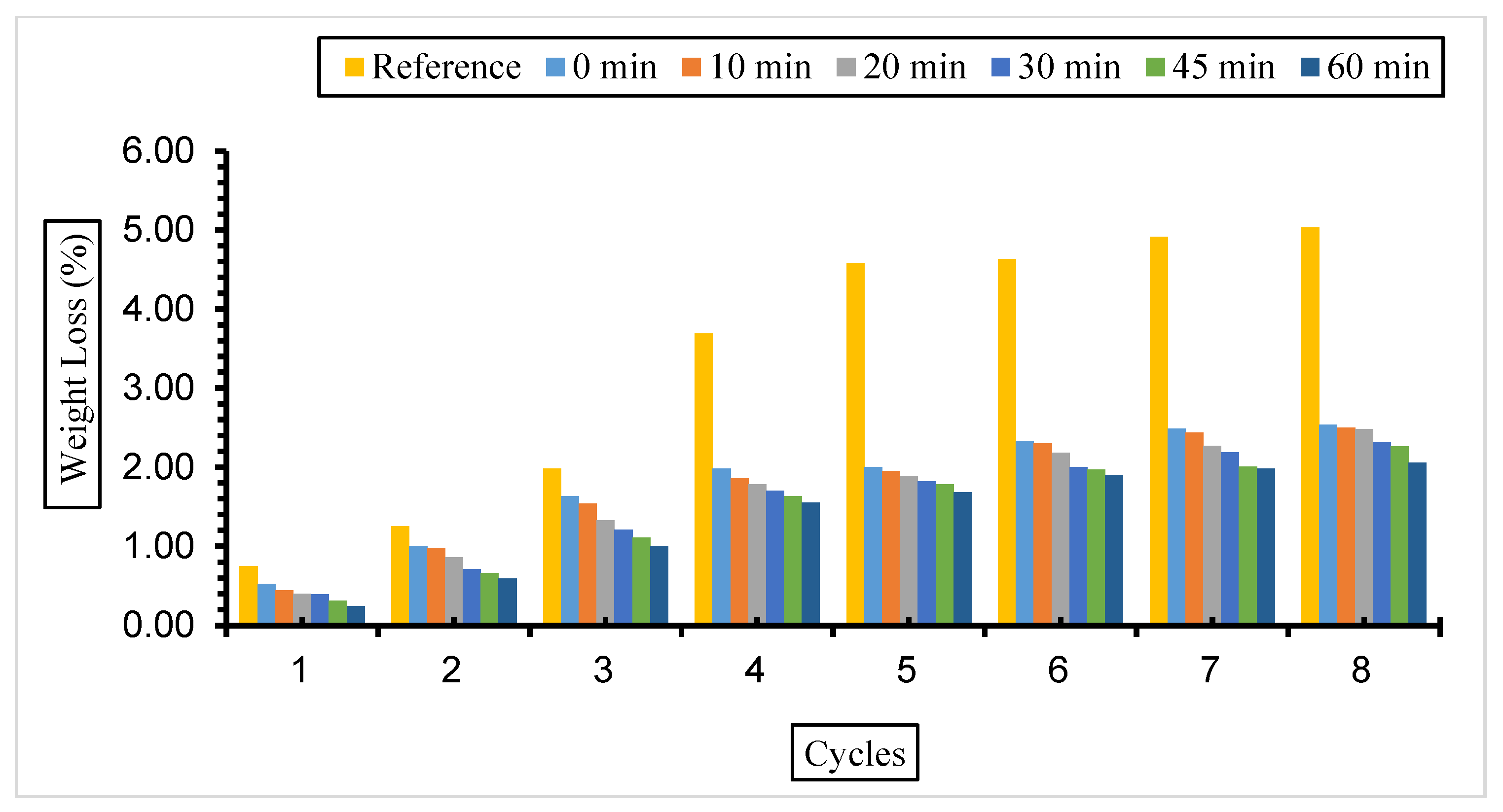
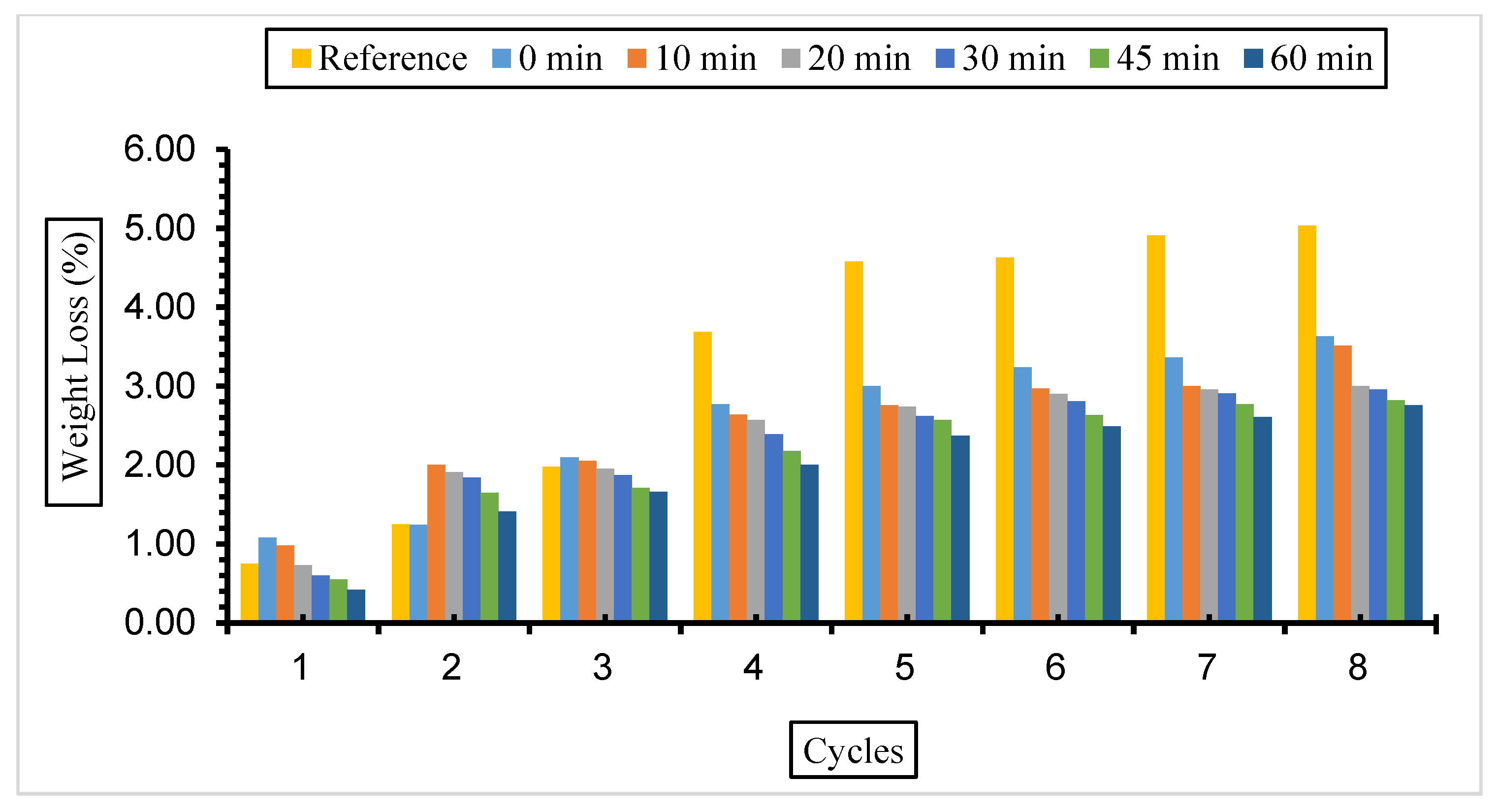
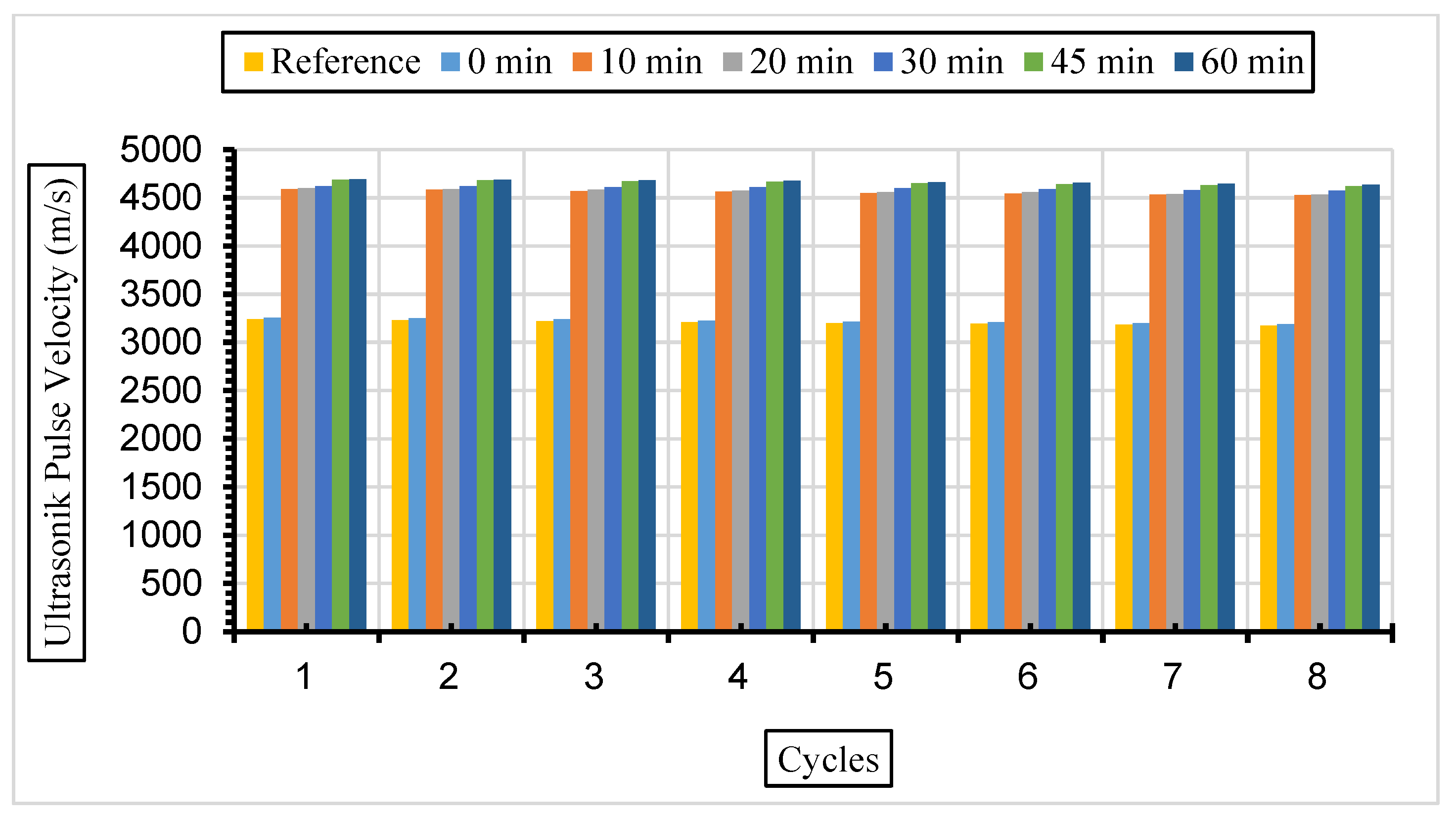
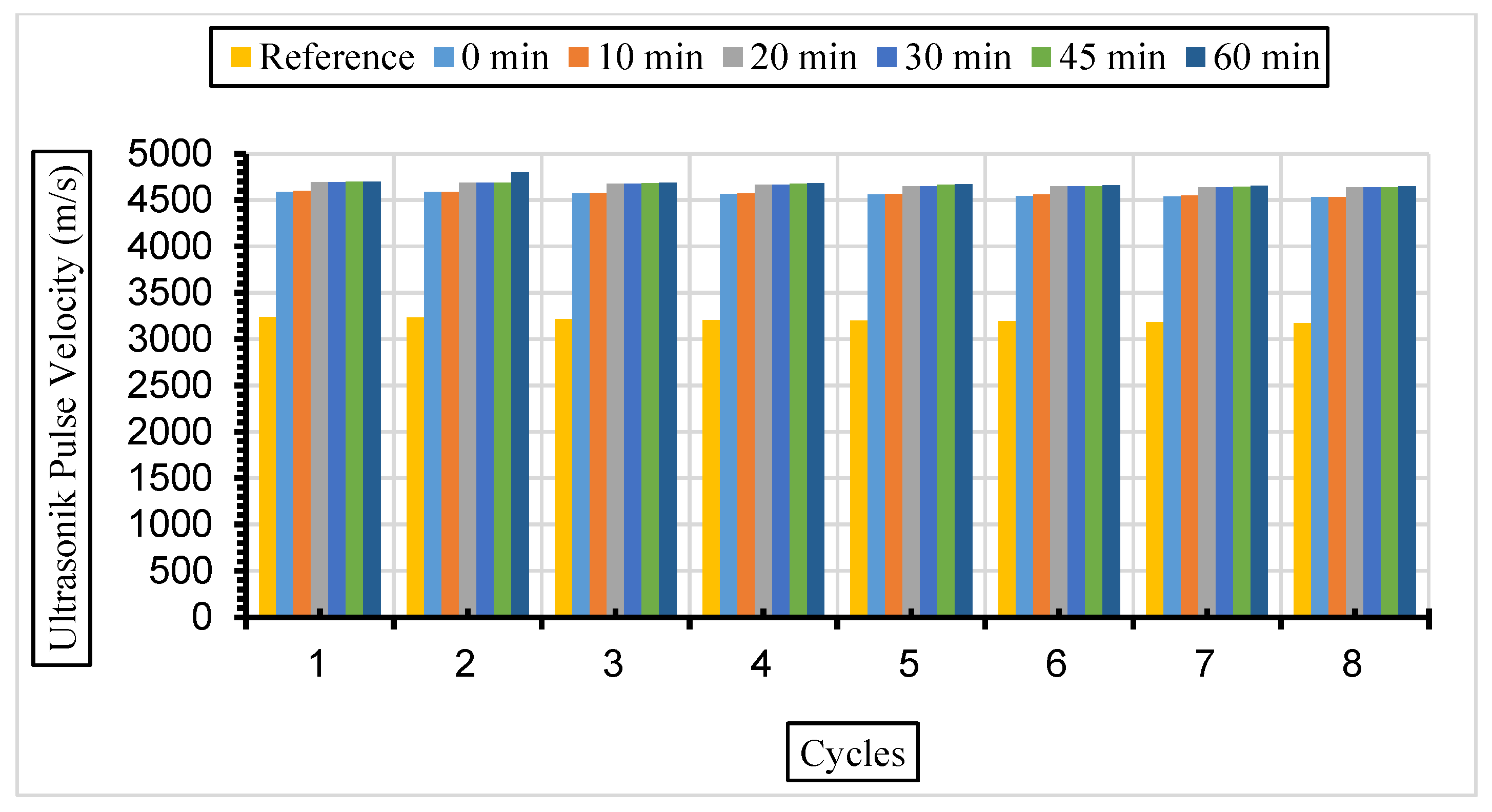
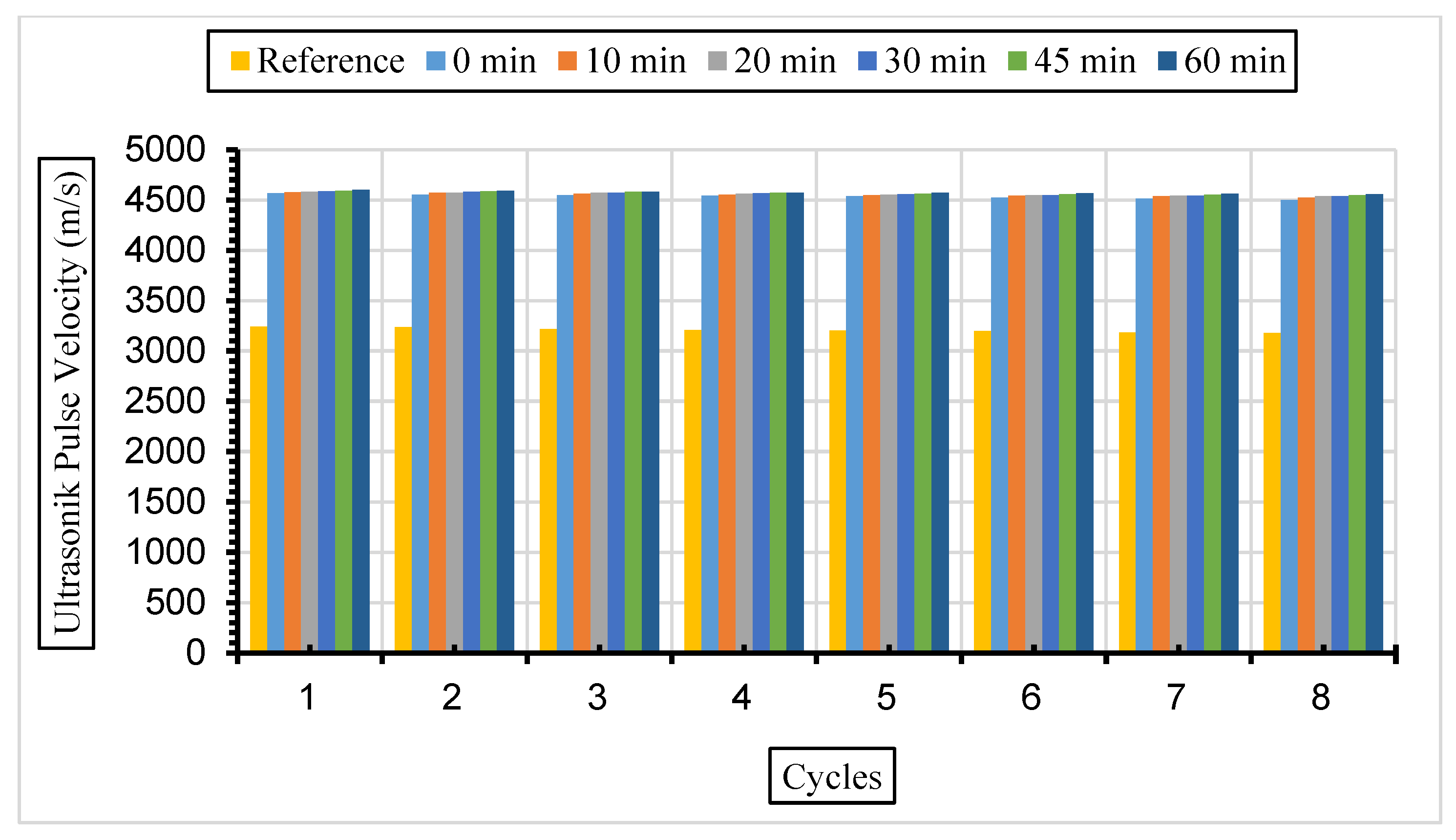
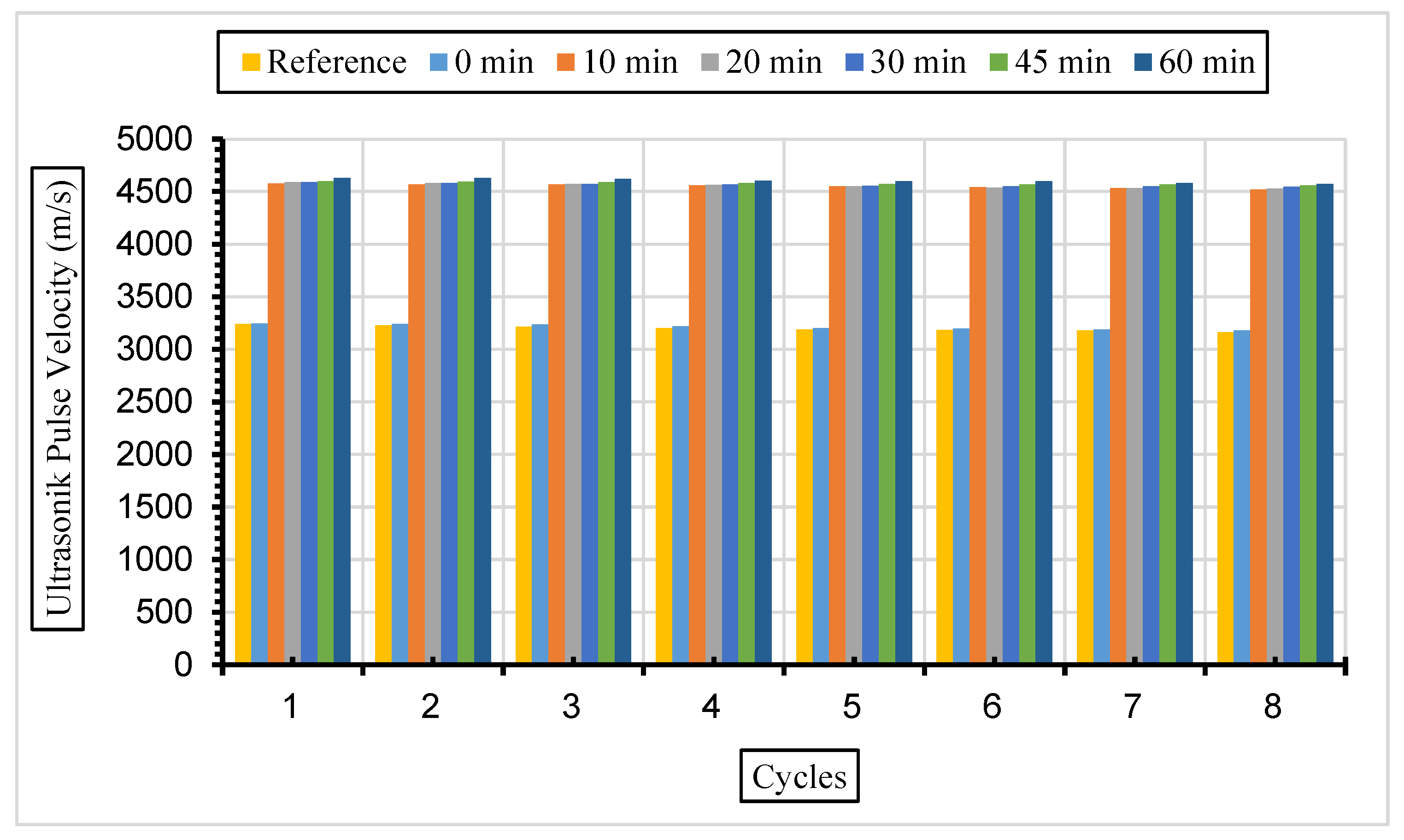
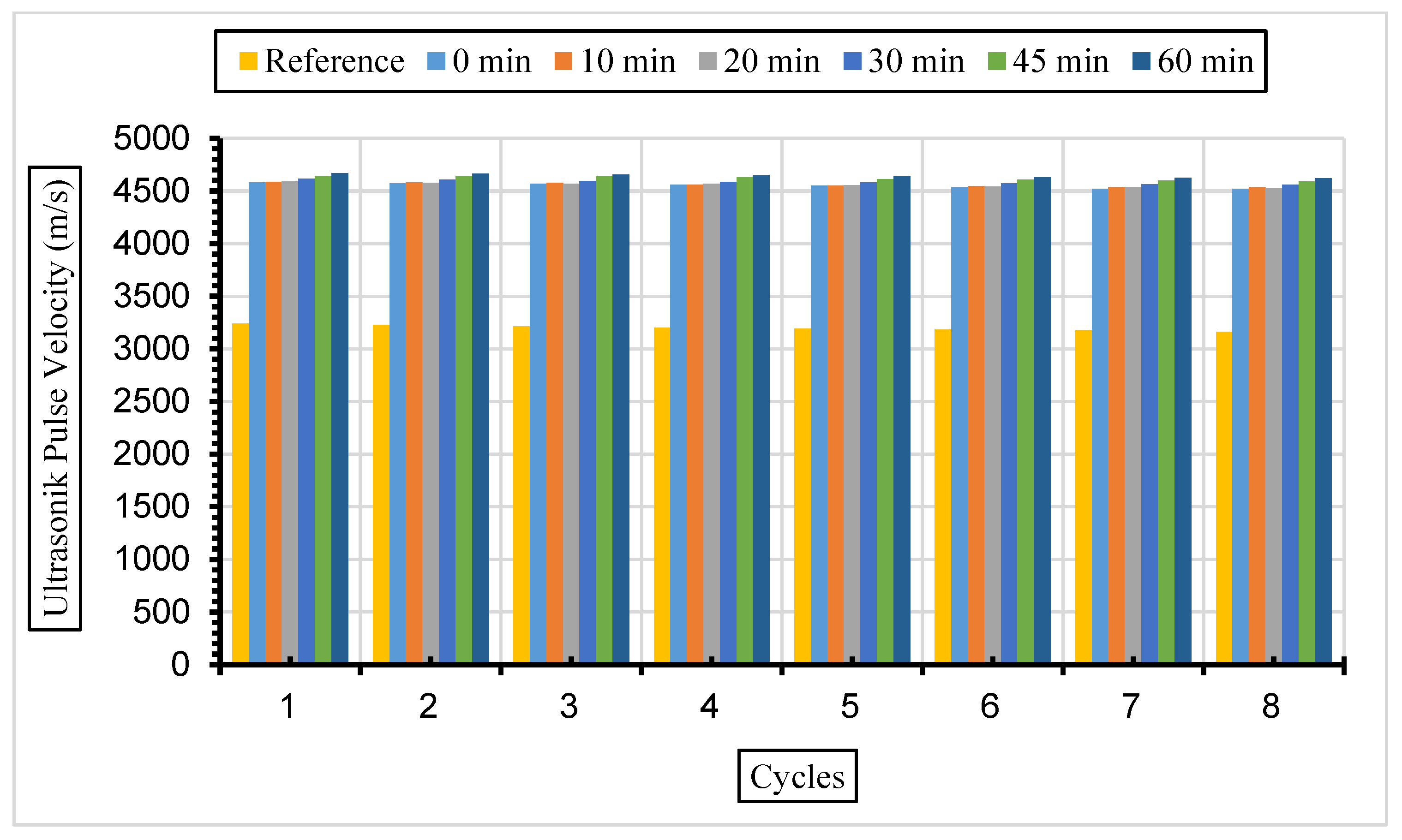
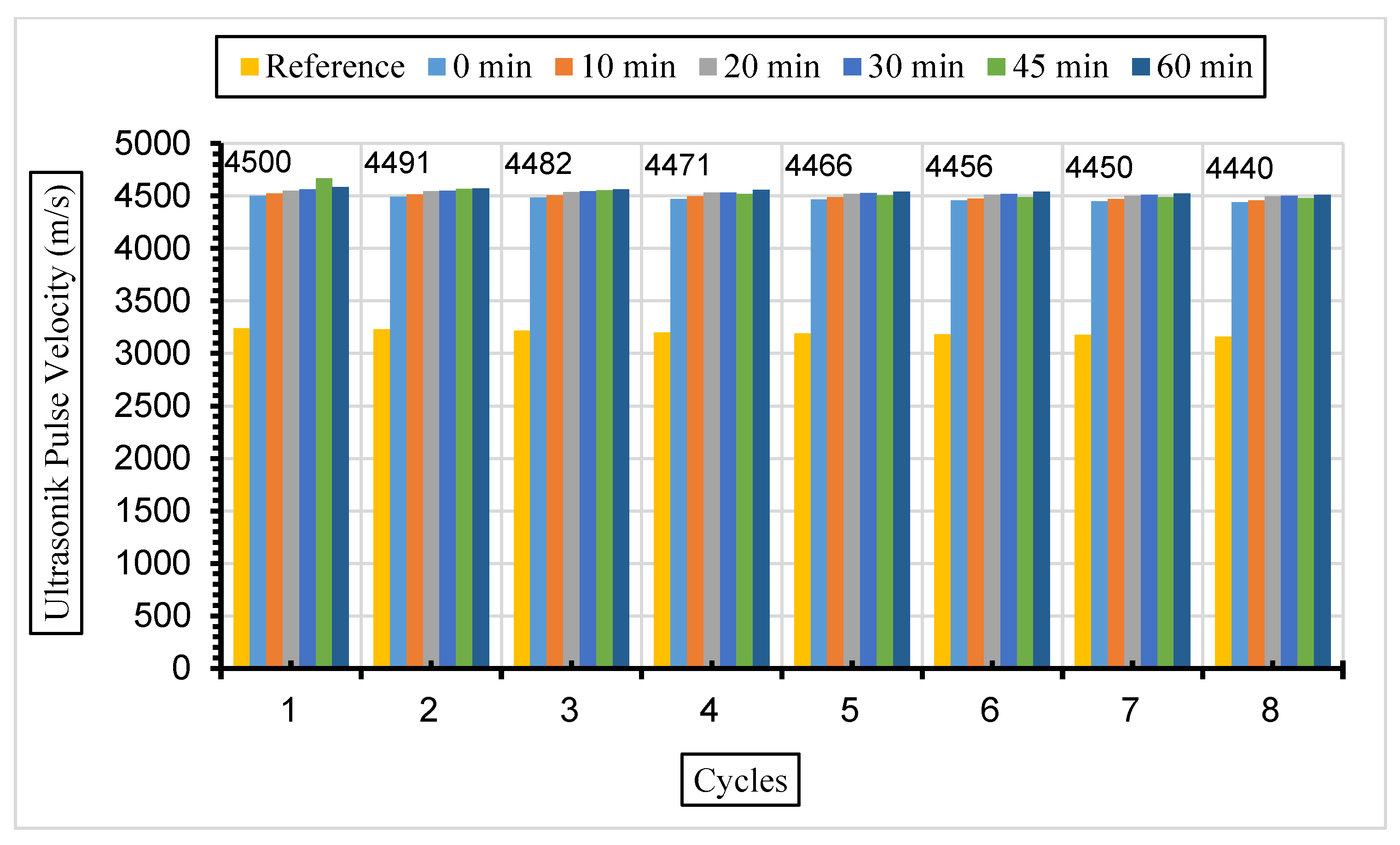
| Chemical Analysis (%) | Physical Tests | ||
|---|---|---|---|
| SiO2 | 16.76 | Thinness (45 μm over the screen. %) | 8.50 |
| Al2O3 | 3.27 | Specific Gravity (g/cm3) | 3.01 |
| Fe2O3 | 3.12 | Blaine (cm2/g) | 4099 |
| CaO | 60.25 | Initial Setting (hours-minutes) | 2 h 45 min |
| MgO | 1.75 | Final Setting (hours-minutes) | 3 h 30 min |
| SO3 | 2.70 | Volume Expansion (mm) | 0.9 |
| Loss of ignition | 5.27 | Water Requirement % | 29.2 |
| Na2O | 0.12 | ||
| K2O | 0.62 | ||
| CI | 0.0171 | Compressive Strength(N/mm2) | |
| Unmeasurable | 5.773 | 2 day | 24.0 |
| Free CaO | 0.35 | 28 day | 51.86 |
| Total | 100 | ||
| Chemical Analysis | Physical Tests | ||
|---|---|---|---|
| Component, % | Fly Ash | Physical Properties | Components |
| SiO2 | 29.20 | Thinness (45 μm over the screen. %) | 50.72 |
| Al2O3 | 11.50 | Specific Gravity (g/cm3) | 2.63 |
| Fe2O3 | 6.54 | Specific Surface (cm2/g) | 1867 |
| CaO | 37.44 | Initial Setting (hours-minutes) | 2 h 45 min |
| MgO | 1.80 | Final Setting (hours-minutes) | 3 h 20 min |
| Na2O | 0.42 | Volume Expansion (mm) | 0 |
| K2O | 0.65 | Water Requirement (%) | 27.7 |
| SO3 | 4.55 | Water Content (g) | 138.5 |
| Cr2O3 | 0.05 | Blaine Test (cm2/g) | |
| Mn2O3 | 0.05 | ||
| P2O5 | 0.45 | 0 min (Uncrushed) 10 min | 1555 |
| TiO2 | 0.50 | 1632 | |
| ZnO | 0.001 | 20 min 30 min | 2347 |
| Loss of ignition | 2.24 | 2589 | |
| Free CaO | 4.61 | 45 min | 2766 |
| Total | 100.00 | 60 min | 3433 |
| Grinding Time of Fly Ash, min | Blaine Fineness, cm2/g |
|---|---|
| 0 (Original Fly Ash) | 1555 |
| 10 | 1632 |
| 20 | 2347 |
| 30 | 2589 |
| 45 | 2766 |
| 60 | 3433 |
| Type of Materials | Fine Aggregate | Medium Aggregate | Coarse Aggregate | w/c | Water (kg/m3) | Cement (kg/m3) | Fly Ash (kg/m3) |
|---|---|---|---|---|---|---|---|
| (0–4 mm) | (4–11.2 mm) | (11.2–22.4 mm) | |||||
| Reference | 686 kg/m3 | 328 kg/m3 | 801 kg/m3 | 0.55 | 190 | 348 | 0 |
| 10% Fly ash substitution | 686 kg/m3 | 328 kg/m3 | 801 kg/m3 | 0.55 | 190 | 313.2 | 34.8 |
| 30% Fly ash substitution | 686 kg/m3 | 328 kg/m3 | 801 kg/m3 | 0.55 | 190 | 243.6 | 104.4 |
| 50% Fly ash substitution | 686 kg/m3 | 328 kg/m3 | 801 kg/m3 | 0.55 | 190 | 174 | 174 |
Disclaimer/Publisher’s Note: The statements, opinions and data contained in all publications are solely those of the individual author(s) and contributor(s) and not of MDPI and/or the editor(s). MDPI and/or the editor(s) disclaim responsibility for any injury to people or property resulting from any ideas, methods, instructions or products referred to in the content. |
© 2024 by the authors. Licensee MDPI, Basel, Switzerland. This article is an open access article distributed under the terms and conditions of the Creative Commons Attribution (CC BY) license (https://creativecommons.org/licenses/by/4.0/).
Share and Cite
Demir Şahin, D.; Eker, H. Effects of Ultrafine Fly Ash against Sulphate Reaction in Concrete Structures. Materials 2024, 17, 1442. https://doi.org/10.3390/ma17061442
Demir Şahin D, Eker H. Effects of Ultrafine Fly Ash against Sulphate Reaction in Concrete Structures. Materials. 2024; 17(6):1442. https://doi.org/10.3390/ma17061442
Chicago/Turabian StyleDemir Şahin, Demet, and Hasan Eker. 2024. "Effects of Ultrafine Fly Ash against Sulphate Reaction in Concrete Structures" Materials 17, no. 6: 1442. https://doi.org/10.3390/ma17061442






